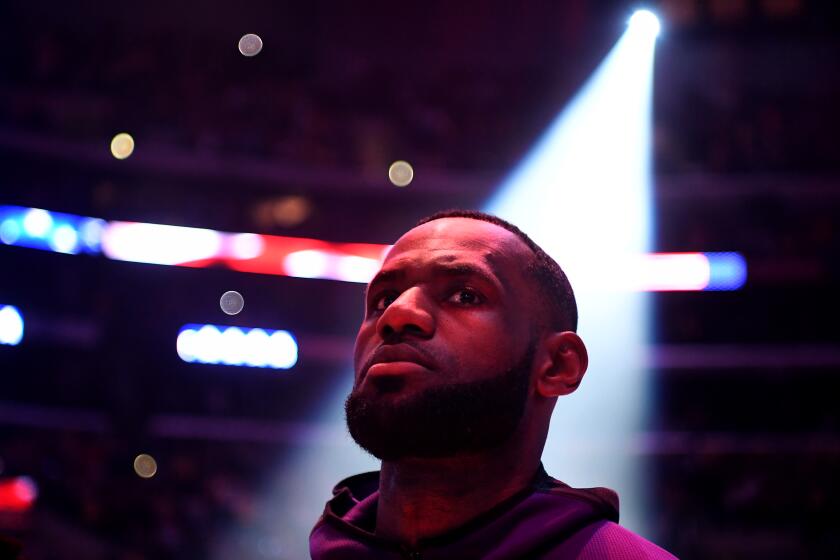Is DH Martinez Hall Bound?
- Share via
SEATTLE — He is a quiet man playing the most disparaged position in baseball. He runs like a truck with flat tires. He needs eye exercises to see straight.
He might be the least likely player to make the Hall of Fame but Edgar Martinez belongs there one day as its first designated hitter.
He has the stroke of genius.
A not-so-ancient Mariner at 40, Martinez is again among the American League leaders in batting average (.333), homers (10), RBIs (36), walks (28), on-base percentage (.448) and slugging percentage (.621). He came into the season unsure if this would be his last. He still doesn’t know. The only people who think he should quit are opposing pitchers.
Martinez surely has no lock on a spot in the Hall of Fame. There are voters among the baseball writers who have hated the DH position since it was created 30 years ago. They consider it an abomination, the worst and most radical rule change in baseball history, and would be loath to give Martinez or any other occupant of that one-dimensional slot a place in the hall. It’s been a job for too many has-been sluggers playing out the string.
I wish the game had been left alone but, like it or not, the DH does exist and Martinez is the best there’s ever been at it. You could stake fair claims for Paul Molitor and Harold Baines, but the right-handed Martinez gets the nod here for his blend of power and average and clutch hits.
If he didn’t have such bum wheels and could beat out some infield hits, Martinez’ lifetime averages of .323 as DH and .317 overall would be even higher. He might also have had a lot more than 15 triples in 15 years.
Martinez notched his 2,000th hit earlier this month and is just 17 shy of 300 homers. They aren’t hall-worthy numbers by themselves, but the way he’s playing right now he just might stick around and beef them up over the next couple of years. His lifetime on-base percentage is a more-than-credible .424.
“I feel younger than 40,” Martinez says. “I don’t feel any different than I did at 30 or 35.”
He doesn’t look any different at the plate, either.
If this does turn out to be Martinez’ final season, he’s worth a last look to see some of the intangibles that elevate a player in the eyes of his peers, if not always the press.
Playing his whole career in Seattle, many of them with some gosh-awful teams, and not given to drawing attention to himself, he has passed under the radar of most of the country except for acknowledgment of his AL batting titles in 1992 and ’95. Seattle fans adore him but he’s Edgar Who? in a lot of other places.
What makes Martinez particularly worth seeing is not just that he is among the purest of hitters but that he keeps getting more out of his recalcitrant body than he probably had a right to expect. He’s been hamstrung by torn hamstrings and balky knees. The last time he played third, he broke four ribs on one play. He got to the majors late, after six years in the minors, but he’s stayed for the long haul.
A burly 5-foot-11, 205, he is strong without the pumped up, sculpted musculature of a contemporary who is certainly destined for the hall -- Barry Bonds. Martinez does more than his share of work in the weight room, but he also has to do daily exercises for an eye condition known as strabismus. His right eye wanders, not good for a hitter facing curves and 90-mph fastballs.
So Martinez carries clear plastic cards with circles on them as exercise tools to get his eyes working together. He holds the cards apart and focuses on the space between them until he sees a circle that appears as if in 3-D. He’s been doing that and other eye exercises for more than 13 years.
“Even though he is a quiet guy, he is the man in this clubhouse that everyone draws on,” says Bob Melvin, who admired Martinez as a rival and has come to appreciate him more this year as Seattle’s new manager. “He’s an inspiration to everyone to see what he goes through with his legs and how he prepares for a game. He goes out there playing with basically half a leg.”
Playing injured, hanging tough, coming through in the clutch are laudable, but they aren’t going to persuade most Hall of Fame voters. They’re going to look at the numbers a player puts up and the position he played.
There are no specific guidelines but for some voters the chief criterion is whether the player is the best, or one of the best, at his position in his era.
“I’m not going to say I deserve to be there, but I’m not going to say that I don’t deserve it,” Martinez says. “Pitchers are in the hall and they pitch once every five days. The DH is in the lineup every day.”
Martinez argues that batting DH can be harder on a hitter than playing the whole game. A regular player can make up for a bad at-bat with a good play in the field. A DH sits and waits anxiously, getting ready for his next turn at the plate a couple of innings before it comes.
“It’s a constant mental drain,” he says.
None have handled that better than Martinez. He’s worth watching now before he’s gone, and worth a vote for the hall when his time comes.
More to Read
Go beyond the scoreboard
Get the latest on L.A.'s teams in the daily Sports Report newsletter.
You may occasionally receive promotional content from the Los Angeles Times.










